NRS-433V: Research Critique on Hand Hygiene in Healthcare Settings
VerifiedAdded on 2023/03/31
|11
|2215
|257
Report
AI Summary
This report presents a critical analysis of four research articles focused on hand hygiene practices and their impact on health outcomes, addressing a PICOT question: "How can hand washing benefit health?" The report examines two quantitative studies that explore the use of electronic monitoring to improve hand hygiene compliance and the comparative efficacy of interventions in hospitals, including systematic reviews and meta-analyses. It also critiques two qualitative studies that delve into healthcare workers' compliance with hand hygiene guidelines and the effectiveness of enhanced performance feedback and patient participation. The analysis covers the background of the studies, research methods, results, and conclusions, along with ethical considerations. The report aims to provide insights into how hand hygiene benefits the healthcare setting.
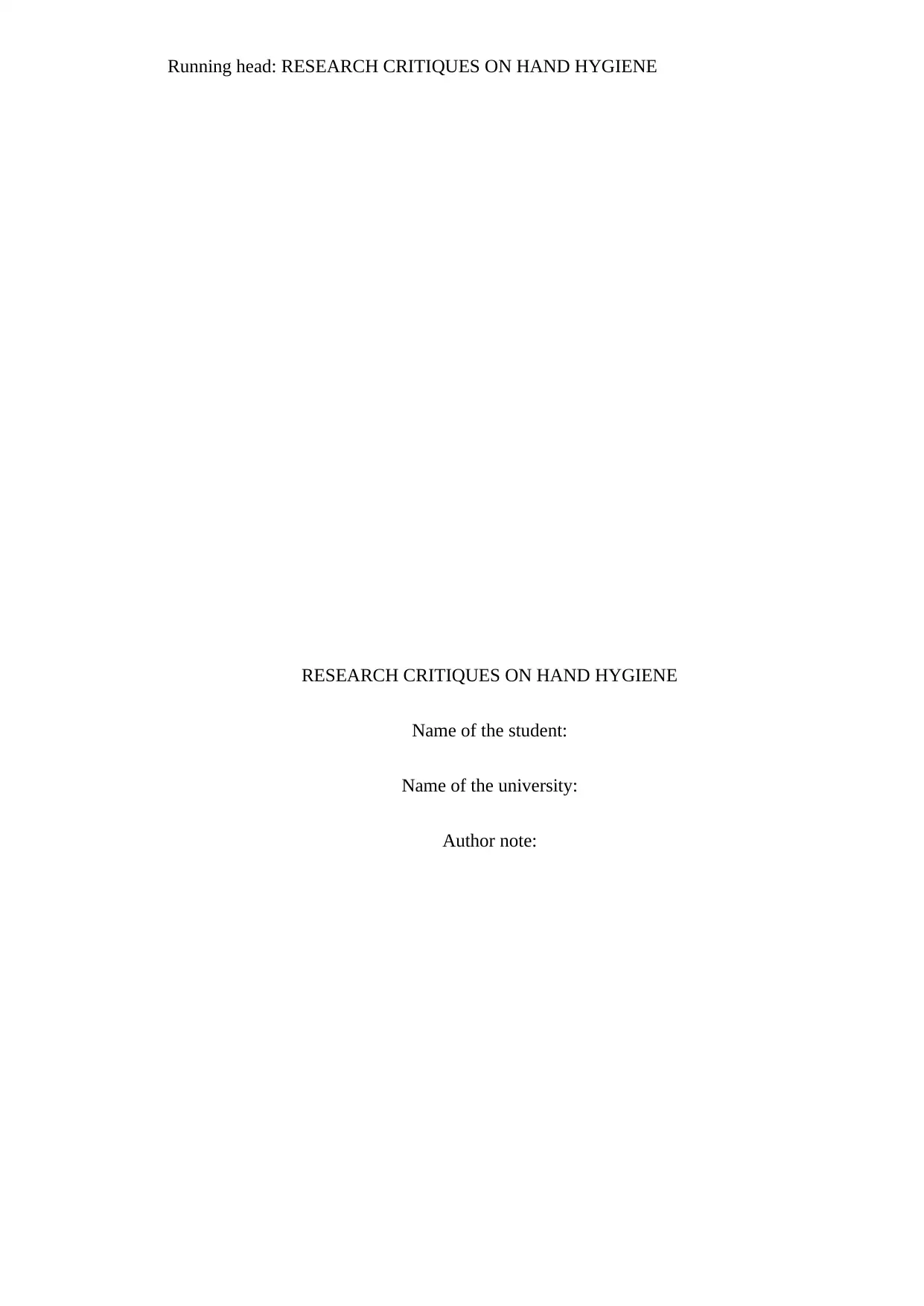
Running head: RESEARCH CRITIQUES ON HAND HYGIENE
RESEARCH CRITIQUES ON HAND HYGIENE
Name of the student:
Name of the university:
Author note:
RESEARCH CRITIQUES ON HAND HYGIENE
Name of the student:
Name of the university:
Author note:
Paraphrase This Document
Need a fresh take? Get an instant paraphrase of this document with our AI Paraphraser
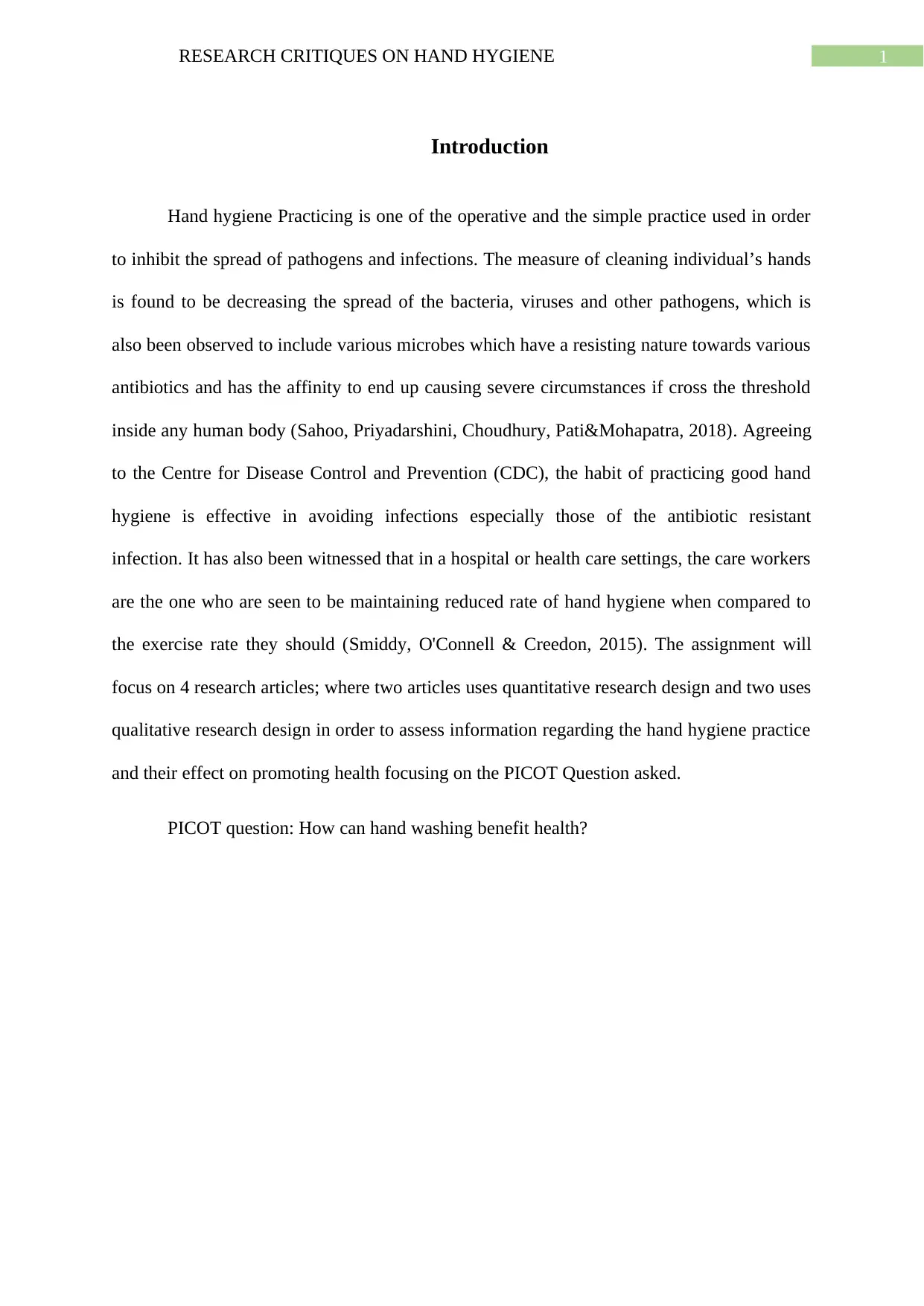
1RESEARCH CRITIQUES ON HAND HYGIENE
Introduction
Hand hygiene Practicing is one of the operative and the simple practice used in order
to inhibit the spread of pathogens and infections. The measure of cleaning individual’s hands
is found to be decreasing the spread of the bacteria, viruses and other pathogens, which is
also been observed to include various microbes which have a resisting nature towards various
antibiotics and has the affinity to end up causing severe circumstances if cross the threshold
inside any human body (Sahoo, Priyadarshini, Choudhury, Pati&Mohapatra, 2018). Agreeing
to the Centre for Disease Control and Prevention (CDC), the habit of practicing good hand
hygiene is effective in avoiding infections especially those of the antibiotic resistant
infection. It has also been witnessed that in a hospital or health care settings, the care workers
are the one who are seen to be maintaining reduced rate of hand hygiene when compared to
the exercise rate they should (Smiddy, O'Connell & Creedon, 2015). The assignment will
focus on 4 research articles; where two articles uses quantitative research design and two uses
qualitative research design in order to assess information regarding the hand hygiene practice
and their effect on promoting health focusing on the PICOT Question asked.
PICOT question: How can hand washing benefit health?
Introduction
Hand hygiene Practicing is one of the operative and the simple practice used in order
to inhibit the spread of pathogens and infections. The measure of cleaning individual’s hands
is found to be decreasing the spread of the bacteria, viruses and other pathogens, which is
also been observed to include various microbes which have a resisting nature towards various
antibiotics and has the affinity to end up causing severe circumstances if cross the threshold
inside any human body (Sahoo, Priyadarshini, Choudhury, Pati&Mohapatra, 2018). Agreeing
to the Centre for Disease Control and Prevention (CDC), the habit of practicing good hand
hygiene is effective in avoiding infections especially those of the antibiotic resistant
infection. It has also been witnessed that in a hospital or health care settings, the care workers
are the one who are seen to be maintaining reduced rate of hand hygiene when compared to
the exercise rate they should (Smiddy, O'Connell & Creedon, 2015). The assignment will
focus on 4 research articles; where two articles uses quantitative research design and two uses
qualitative research design in order to assess information regarding the hand hygiene practice
and their effect on promoting health focusing on the PICOT Question asked.
PICOT question: How can hand washing benefit health?

2RESEARCH CRITIQUES ON HAND HYGIENE
Quantitative study
Article 1: Motivating Process Compliance Through Individual Electronic Monitoring:
An Empirical Examination of Hand Hygiene in Healthcare
Staats, B. R., Dai, H., Hofmann, D., & Milkman, K. L. (2016). Motivating process
compliance through individual electronic monitoring: An empirical examination of hand
hygiene in healthcare. Management Science, 63(5), 1563-
1585.https://doi.org/10.1287/mnsc.2015.2400
Article 2: Comparative efficacy of interventions to promote hand hygiene in hospital:
systematic review and network meta-analysis
Luangasanatip, N., Hongsuwan, M., Limmathurotsakul, D., Lubell, Y., Lee, A. S.,
Harbarth, S., ... & Cooper, B. S. (2015). Comparative efficacy of interventions to promote
hand hygiene in hospital: systematic review and network meta-analysis. bmj, 351,
h3728.https://doi.org/10.1136/bmj.h3728
Background of the study
In Article 1, the aim of the research was to study the motivating process observance
with the use of Individual Electronic Monitoring which is an experiential assessment of the
Hand Hygiene practice in the health division. The researcher conducted the study using an
exceptional method which was the use of radio frequency identification (RFID) in almost 71
health care units (Sakihama et al., 2016). They observed that the process of the electronically
monitoring each and every individual obedience has resulted into a greater and a positive
raise in the obedience towards the health hygiene practice.
In article 2, the aim of the researcher was to study the comparative effectiveness of
the interventions that has been proposed in instruction to promote the hand hygiene
application in the health care organization using systematic assessment and also system meta-
Quantitative study
Article 1: Motivating Process Compliance Through Individual Electronic Monitoring:
An Empirical Examination of Hand Hygiene in Healthcare
Staats, B. R., Dai, H., Hofmann, D., & Milkman, K. L. (2016). Motivating process
compliance through individual electronic monitoring: An empirical examination of hand
hygiene in healthcare. Management Science, 63(5), 1563-
1585.https://doi.org/10.1287/mnsc.2015.2400
Article 2: Comparative efficacy of interventions to promote hand hygiene in hospital:
systematic review and network meta-analysis
Luangasanatip, N., Hongsuwan, M., Limmathurotsakul, D., Lubell, Y., Lee, A. S.,
Harbarth, S., ... & Cooper, B. S. (2015). Comparative efficacy of interventions to promote
hand hygiene in hospital: systematic review and network meta-analysis. bmj, 351,
h3728.https://doi.org/10.1136/bmj.h3728
Background of the study
In Article 1, the aim of the research was to study the motivating process observance
with the use of Individual Electronic Monitoring which is an experiential assessment of the
Hand Hygiene practice in the health division. The researcher conducted the study using an
exceptional method which was the use of radio frequency identification (RFID) in almost 71
health care units (Sakihama et al., 2016). They observed that the process of the electronically
monitoring each and every individual obedience has resulted into a greater and a positive
raise in the obedience towards the health hygiene practice.
In article 2, the aim of the researcher was to study the comparative effectiveness of
the interventions that has been proposed in instruction to promote the hand hygiene
application in the health care organization using systematic assessment and also system meta-
⊘ This is a preview!⊘
Do you want full access?
Subscribe today to unlock all pages.

Trusted by 1+ million students worldwide
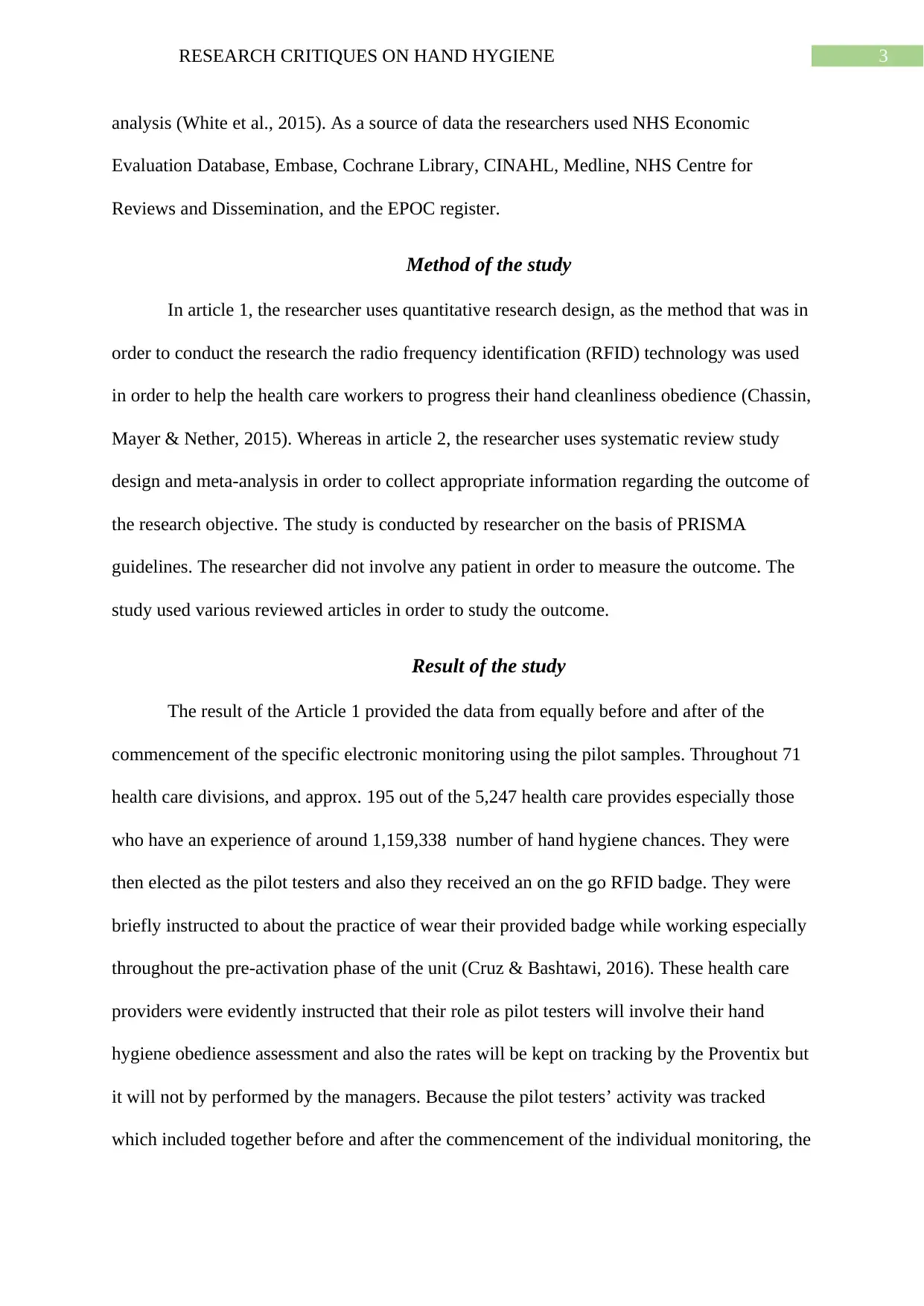
3RESEARCH CRITIQUES ON HAND HYGIENE
analysis (White et al., 2015). As a source of data the researchers used NHS Economic
Evaluation Database, Embase, Cochrane Library, CINAHL, Medline, NHS Centre for
Reviews and Dissemination, and the EPOC register.
Method of the study
In article 1, the researcher uses quantitative research design, as the method that was in
order to conduct the research the radio frequency identification (RFID) technology was used
in order to help the health care workers to progress their hand cleanliness obedience (Chassin,
Mayer & Nether, 2015). Whereas in article 2, the researcher uses systematic review study
design and meta-analysis in order to collect appropriate information regarding the outcome of
the research objective. The study is conducted by researcher on the basis of PRISMA
guidelines. The researcher did not involve any patient in order to measure the outcome. The
study used various reviewed articles in order to study the outcome.
Result of the study
The result of the Article 1 provided the data from equally before and after of the
commencement of the specific electronic monitoring using the pilot samples. Throughout 71
health care divisions, and approx. 195 out of the 5,247 health care provides especially those
who have an experience of around 1,159,338 number of hand hygiene chances. They were
then elected as the pilot testers and also they received an on the go RFID badge. They were
briefly instructed to about the practice of wear their provided badge while working especially
throughout the pre-activation phase of the unit (Cruz & Bashtawi, 2016). These health care
providers were evidently instructed that their role as pilot testers will involve their hand
hygiene obedience assessment and also the rates will be kept on tracking by the Proventix but
it will not by performed by the managers. Because the pilot testers’ activity was tracked
which included together before and after the commencement of the individual monitoring, the
analysis (White et al., 2015). As a source of data the researchers used NHS Economic
Evaluation Database, Embase, Cochrane Library, CINAHL, Medline, NHS Centre for
Reviews and Dissemination, and the EPOC register.
Method of the study
In article 1, the researcher uses quantitative research design, as the method that was in
order to conduct the research the radio frequency identification (RFID) technology was used
in order to help the health care workers to progress their hand cleanliness obedience (Chassin,
Mayer & Nether, 2015). Whereas in article 2, the researcher uses systematic review study
design and meta-analysis in order to collect appropriate information regarding the outcome of
the research objective. The study is conducted by researcher on the basis of PRISMA
guidelines. The researcher did not involve any patient in order to measure the outcome. The
study used various reviewed articles in order to study the outcome.
Result of the study
The result of the Article 1 provided the data from equally before and after of the
commencement of the specific electronic monitoring using the pilot samples. Throughout 71
health care divisions, and approx. 195 out of the 5,247 health care provides especially those
who have an experience of around 1,159,338 number of hand hygiene chances. They were
then elected as the pilot testers and also they received an on the go RFID badge. They were
briefly instructed to about the practice of wear their provided badge while working especially
throughout the pre-activation phase of the unit (Cruz & Bashtawi, 2016). These health care
providers were evidently instructed that their role as pilot testers will involve their hand
hygiene obedience assessment and also the rates will be kept on tracking by the Proventix but
it will not by performed by the managers. Because the pilot testers’ activity was tracked
which included together before and after the commencement of the individual monitoring, the
Paraphrase This Document
Need a fresh take? Get an instant paraphrase of this document with our AI Paraphraser

4RESEARCH CRITIQUES ON HAND HYGIENE
researcher was capable of identifying an accurate effect of the activation of the individual
monitoring on the basis of their observance rates.
The result of Article 2 was retrieved from 3639 different studies where only 41 met
the proposed insertion criteria which included around six randomized controlled trials,
approximately 32 remained from interrupted time series, a single existed from a non-
randomized trial at last only two were for controlled studies that of before-after analysis. Also
they conducted meta-analysis of 2 selected randomized controlled trials which displayed the
accumulation of the area setting to the World Health Organization-5 as related directly to the
process of improved compliance.
Conclusion of the study
The conclusion of article 1 stated that, they found out that the practice of electronic
monitoring is the most effective technique that the health care managers can employ in order
to noticeably progress the standardized procedure obedience. There were other findings
which stated that, after the monitoring was being terminated, the rate of obedience towards
the practice fall lower than the original rate, the usual levels generally offers a warning note
towards the health care managers (Staats, Dai, Hofmann & Milkman, 2016).
The conclusion of article 2 stated that, the encouragement of the hand hygiene
practice with the help of WHO-5 is an effective measure in directive to increase the
obedience of health hygiene between the health care employees. Also, the accumulation of
the recompense incentives, goal setting, and also responsibility strategies has been proved to
be a positive measure to lead to advance improvements in the health care organization.
Exposures of the provided resources that are necessary for such kind of interventions are
found to remain insufficient (Luangasanatip et al., 2015).
researcher was capable of identifying an accurate effect of the activation of the individual
monitoring on the basis of their observance rates.
The result of Article 2 was retrieved from 3639 different studies where only 41 met
the proposed insertion criteria which included around six randomized controlled trials,
approximately 32 remained from interrupted time series, a single existed from a non-
randomized trial at last only two were for controlled studies that of before-after analysis. Also
they conducted meta-analysis of 2 selected randomized controlled trials which displayed the
accumulation of the area setting to the World Health Organization-5 as related directly to the
process of improved compliance.
Conclusion of the study
The conclusion of article 1 stated that, they found out that the practice of electronic
monitoring is the most effective technique that the health care managers can employ in order
to noticeably progress the standardized procedure obedience. There were other findings
which stated that, after the monitoring was being terminated, the rate of obedience towards
the practice fall lower than the original rate, the usual levels generally offers a warning note
towards the health care managers (Staats, Dai, Hofmann & Milkman, 2016).
The conclusion of article 2 stated that, the encouragement of the hand hygiene
practice with the help of WHO-5 is an effective measure in directive to increase the
obedience of health hygiene between the health care employees. Also, the accumulation of
the recompense incentives, goal setting, and also responsibility strategies has been proved to
be a positive measure to lead to advance improvements in the health care organization.
Exposures of the provided resources that are necessary for such kind of interventions are
found to remain insufficient (Luangasanatip et al., 2015).
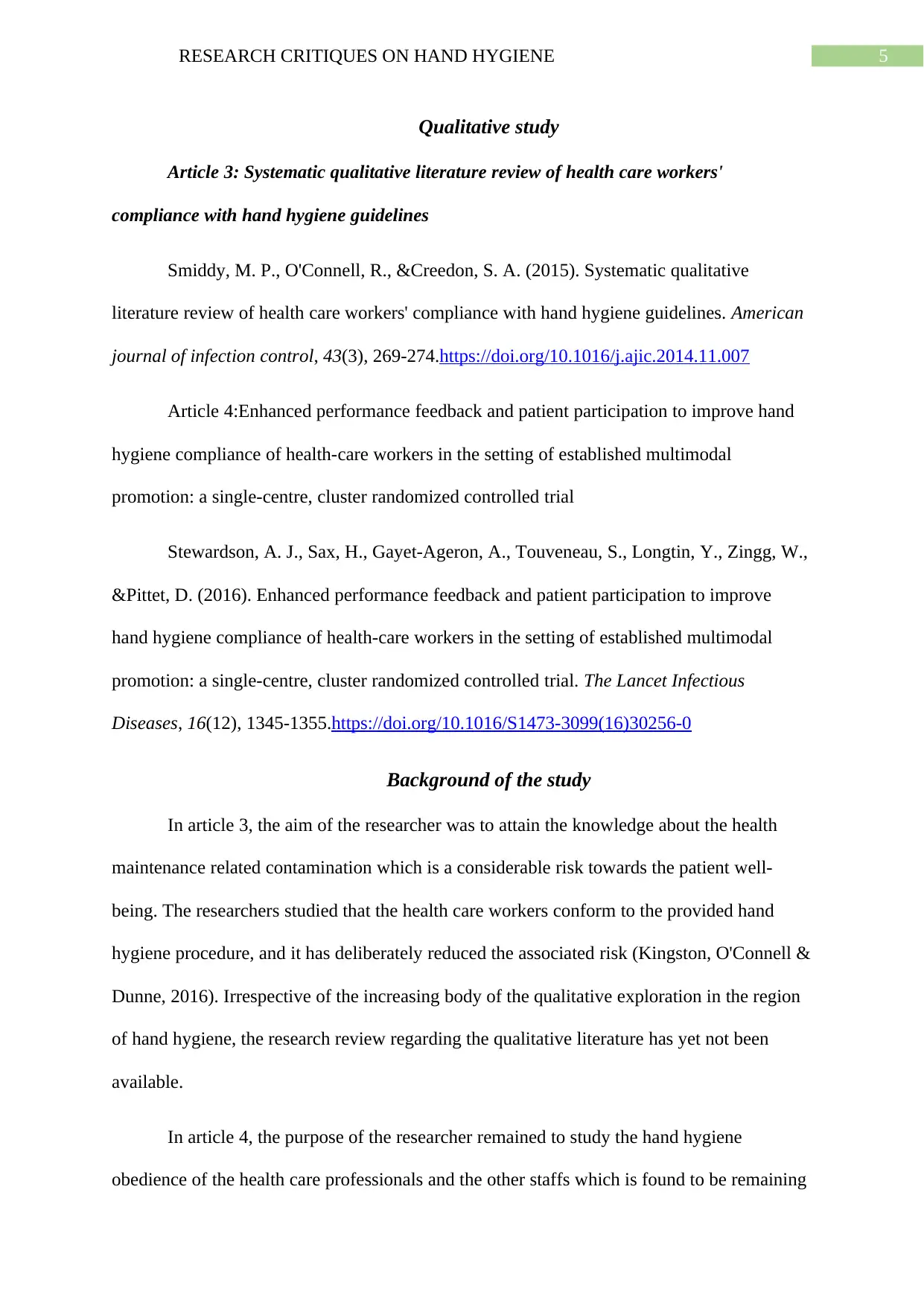
5RESEARCH CRITIQUES ON HAND HYGIENE
Qualitative study
Article 3: Systematic qualitative literature review of health care workers'
compliance with hand hygiene guidelines
Smiddy, M. P., O'Connell, R., &Creedon, S. A. (2015). Systematic qualitative
literature review of health care workers' compliance with hand hygiene guidelines. American
journal of infection control, 43(3), 269-274.https://doi.org/10.1016/j.ajic.2014.11.007
Article 4:Enhanced performance feedback and patient participation to improve hand
hygiene compliance of health-care workers in the setting of established multimodal
promotion: a single-centre, cluster randomized controlled trial
Stewardson, A. J., Sax, H., Gayet-Ageron, A., Touveneau, S., Longtin, Y., Zingg, W.,
&Pittet, D. (2016). Enhanced performance feedback and patient participation to improve
hand hygiene compliance of health-care workers in the setting of established multimodal
promotion: a single-centre, cluster randomized controlled trial. The Lancet Infectious
Diseases, 16(12), 1345-1355.https://doi.org/10.1016/S1473-3099(16)30256-0
Background of the study
In article 3, the aim of the researcher was to attain the knowledge about the health
maintenance related contamination which is a considerable risk towards the patient well-
being. The researchers studied that the health care workers conform to the provided hand
hygiene procedure, and it has deliberately reduced the associated risk (Kingston, O'Connell &
Dunne, 2016). Irrespective of the increasing body of the qualitative exploration in the region
of hand hygiene, the research review regarding the qualitative literature has yet not been
available.
In article 4, the purpose of the researcher remained to study the hand hygiene
obedience of the health care professionals and the other staffs which is found to be remaining
Qualitative study
Article 3: Systematic qualitative literature review of health care workers'
compliance with hand hygiene guidelines
Smiddy, M. P., O'Connell, R., &Creedon, S. A. (2015). Systematic qualitative
literature review of health care workers' compliance with hand hygiene guidelines. American
journal of infection control, 43(3), 269-274.https://doi.org/10.1016/j.ajic.2014.11.007
Article 4:Enhanced performance feedback and patient participation to improve hand
hygiene compliance of health-care workers in the setting of established multimodal
promotion: a single-centre, cluster randomized controlled trial
Stewardson, A. J., Sax, H., Gayet-Ageron, A., Touveneau, S., Longtin, Y., Zingg, W.,
&Pittet, D. (2016). Enhanced performance feedback and patient participation to improve
hand hygiene compliance of health-care workers in the setting of established multimodal
promotion: a single-centre, cluster randomized controlled trial. The Lancet Infectious
Diseases, 16(12), 1345-1355.https://doi.org/10.1016/S1473-3099(16)30256-0
Background of the study
In article 3, the aim of the researcher was to attain the knowledge about the health
maintenance related contamination which is a considerable risk towards the patient well-
being. The researchers studied that the health care workers conform to the provided hand
hygiene procedure, and it has deliberately reduced the associated risk (Kingston, O'Connell &
Dunne, 2016). Irrespective of the increasing body of the qualitative exploration in the region
of hand hygiene, the research review regarding the qualitative literature has yet not been
available.
In article 4, the purpose of the researcher remained to study the hand hygiene
obedience of the health care professionals and the other staffs which is found to be remaining
⊘ This is a preview!⊘
Do you want full access?
Subscribe today to unlock all pages.

Trusted by 1+ million students worldwide
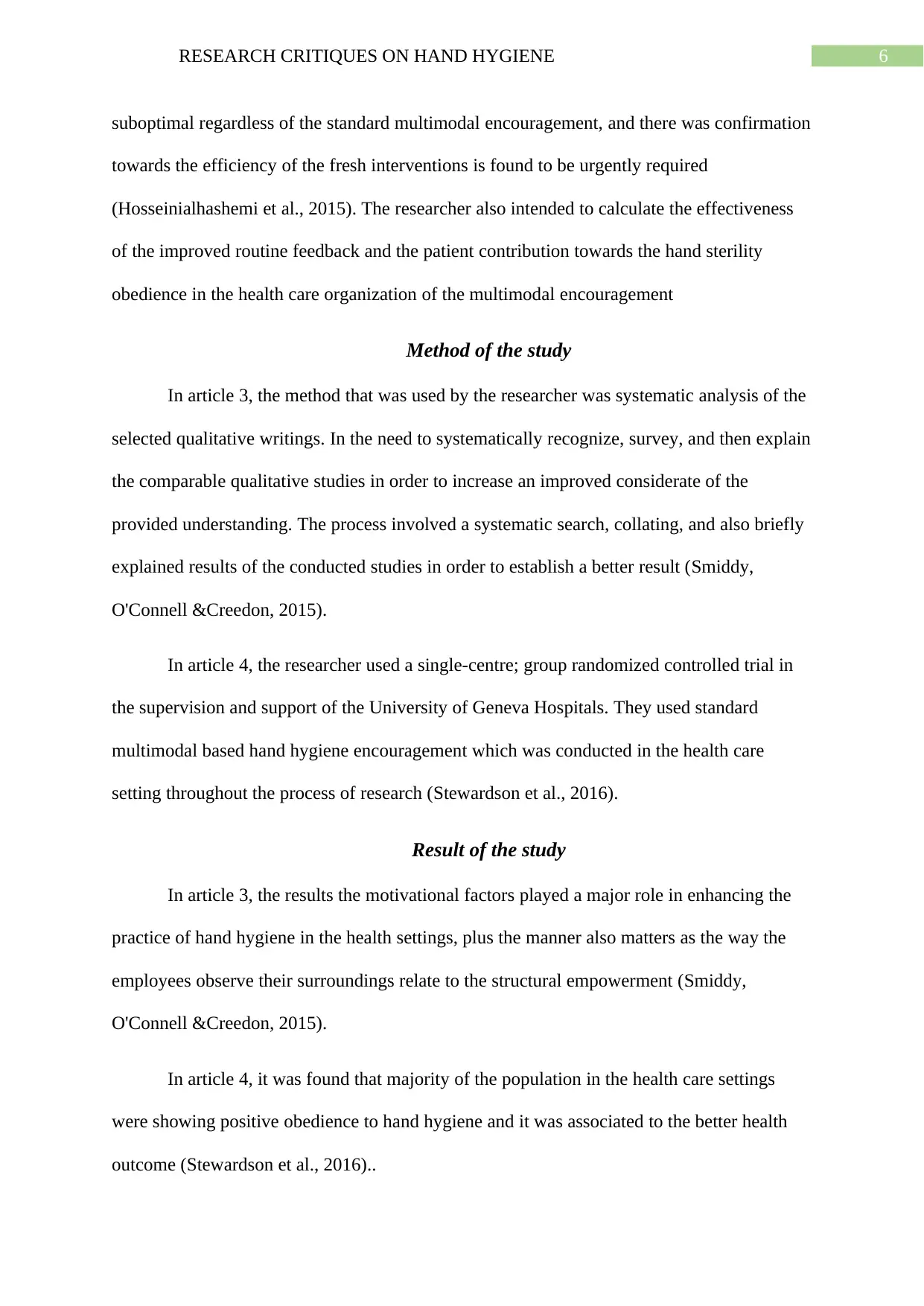
6RESEARCH CRITIQUES ON HAND HYGIENE
suboptimal regardless of the standard multimodal encouragement, and there was confirmation
towards the efficiency of the fresh interventions is found to be urgently required
(Hosseinialhashemi et al., 2015). The researcher also intended to calculate the effectiveness
of the improved routine feedback and the patient contribution towards the hand sterility
obedience in the health care organization of the multimodal encouragement
Method of the study
In article 3, the method that was used by the researcher was systematic analysis of the
selected qualitative writings. In the need to systematically recognize, survey, and then explain
the comparable qualitative studies in order to increase an improved considerate of the
provided understanding. The process involved a systematic search, collating, and also briefly
explained results of the conducted studies in order to establish a better result (Smiddy,
O'Connell &Creedon, 2015).
In article 4, the researcher used a single-centre; group randomized controlled trial in
the supervision and support of the University of Geneva Hospitals. They used standard
multimodal based hand hygiene encouragement which was conducted in the health care
setting throughout the process of research (Stewardson et al., 2016).
Result of the study
In article 3, the results the motivational factors played a major role in enhancing the
practice of hand hygiene in the health settings, plus the manner also matters as the way the
employees observe their surroundings relate to the structural empowerment (Smiddy,
O'Connell &Creedon, 2015).
In article 4, it was found that majority of the population in the health care settings
were showing positive obedience to hand hygiene and it was associated to the better health
outcome (Stewardson et al., 2016)..
suboptimal regardless of the standard multimodal encouragement, and there was confirmation
towards the efficiency of the fresh interventions is found to be urgently required
(Hosseinialhashemi et al., 2015). The researcher also intended to calculate the effectiveness
of the improved routine feedback and the patient contribution towards the hand sterility
obedience in the health care organization of the multimodal encouragement
Method of the study
In article 3, the method that was used by the researcher was systematic analysis of the
selected qualitative writings. In the need to systematically recognize, survey, and then explain
the comparable qualitative studies in order to increase an improved considerate of the
provided understanding. The process involved a systematic search, collating, and also briefly
explained results of the conducted studies in order to establish a better result (Smiddy,
O'Connell &Creedon, 2015).
In article 4, the researcher used a single-centre; group randomized controlled trial in
the supervision and support of the University of Geneva Hospitals. They used standard
multimodal based hand hygiene encouragement which was conducted in the health care
setting throughout the process of research (Stewardson et al., 2016).
Result of the study
In article 3, the results the motivational factors played a major role in enhancing the
practice of hand hygiene in the health settings, plus the manner also matters as the way the
employees observe their surroundings relate to the structural empowerment (Smiddy,
O'Connell &Creedon, 2015).
In article 4, it was found that majority of the population in the health care settings
were showing positive obedience to hand hygiene and it was associated to the better health
outcome (Stewardson et al., 2016)..
Paraphrase This Document
Need a fresh take? Get an instant paraphrase of this document with our AI Paraphraser
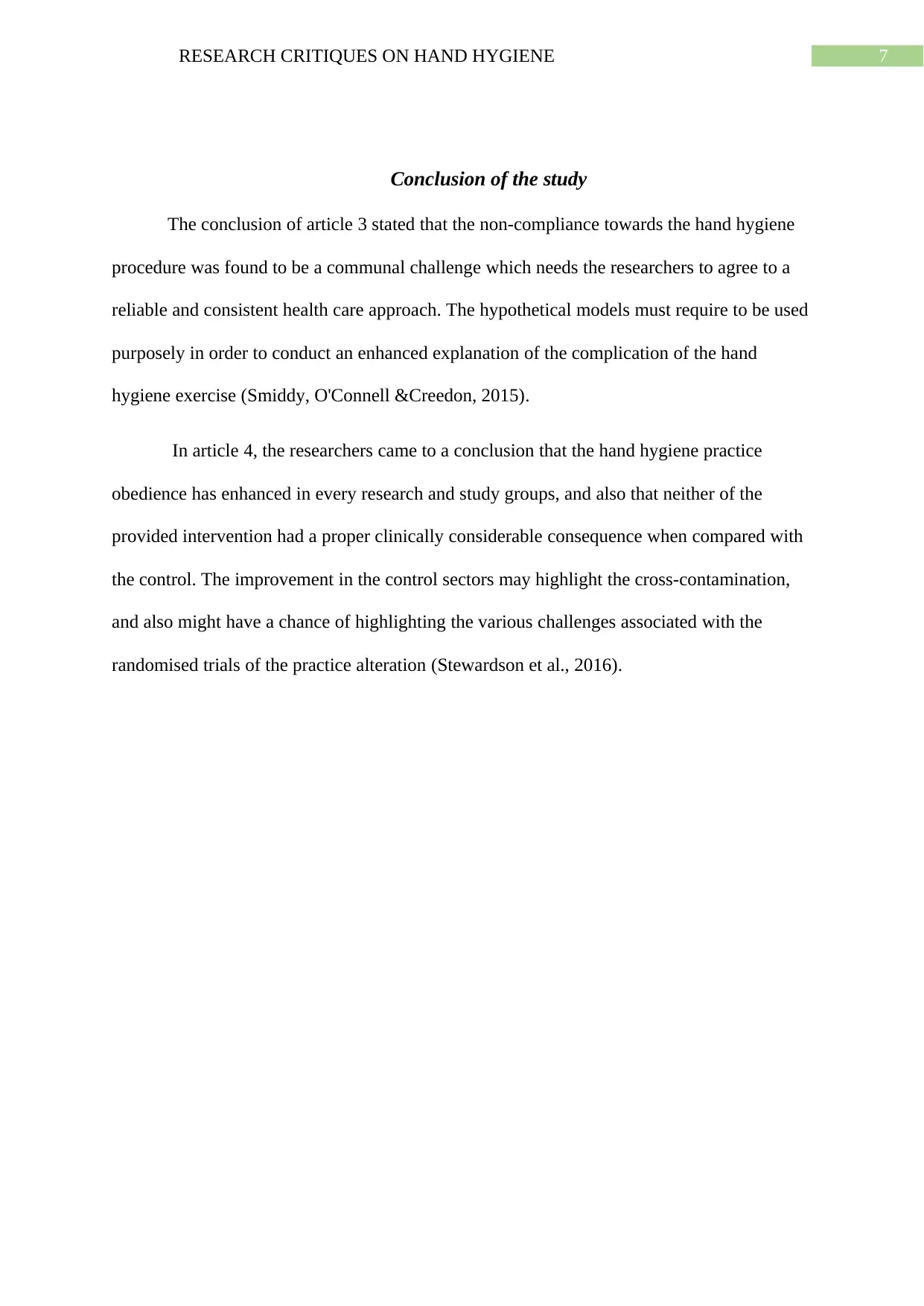
7RESEARCH CRITIQUES ON HAND HYGIENE
Conclusion of the study
The conclusion of article 3 stated that the non-compliance towards the hand hygiene
procedure was found to be a communal challenge which needs the researchers to agree to a
reliable and consistent health care approach. The hypothetical models must require to be used
purposely in order to conduct an enhanced explanation of the complication of the hand
hygiene exercise (Smiddy, O'Connell &Creedon, 2015).
In article 4, the researchers came to a conclusion that the hand hygiene practice
obedience has enhanced in every research and study groups, and also that neither of the
provided intervention had a proper clinically considerable consequence when compared with
the control. The improvement in the control sectors may highlight the cross-contamination,
and also might have a chance of highlighting the various challenges associated with the
randomised trials of the practice alteration (Stewardson et al., 2016).
Conclusion of the study
The conclusion of article 3 stated that the non-compliance towards the hand hygiene
procedure was found to be a communal challenge which needs the researchers to agree to a
reliable and consistent health care approach. The hypothetical models must require to be used
purposely in order to conduct an enhanced explanation of the complication of the hand
hygiene exercise (Smiddy, O'Connell &Creedon, 2015).
In article 4, the researchers came to a conclusion that the hand hygiene practice
obedience has enhanced in every research and study groups, and also that neither of the
provided intervention had a proper clinically considerable consequence when compared with
the control. The improvement in the control sectors may highlight the cross-contamination,
and also might have a chance of highlighting the various challenges associated with the
randomised trials of the practice alteration (Stewardson et al., 2016).
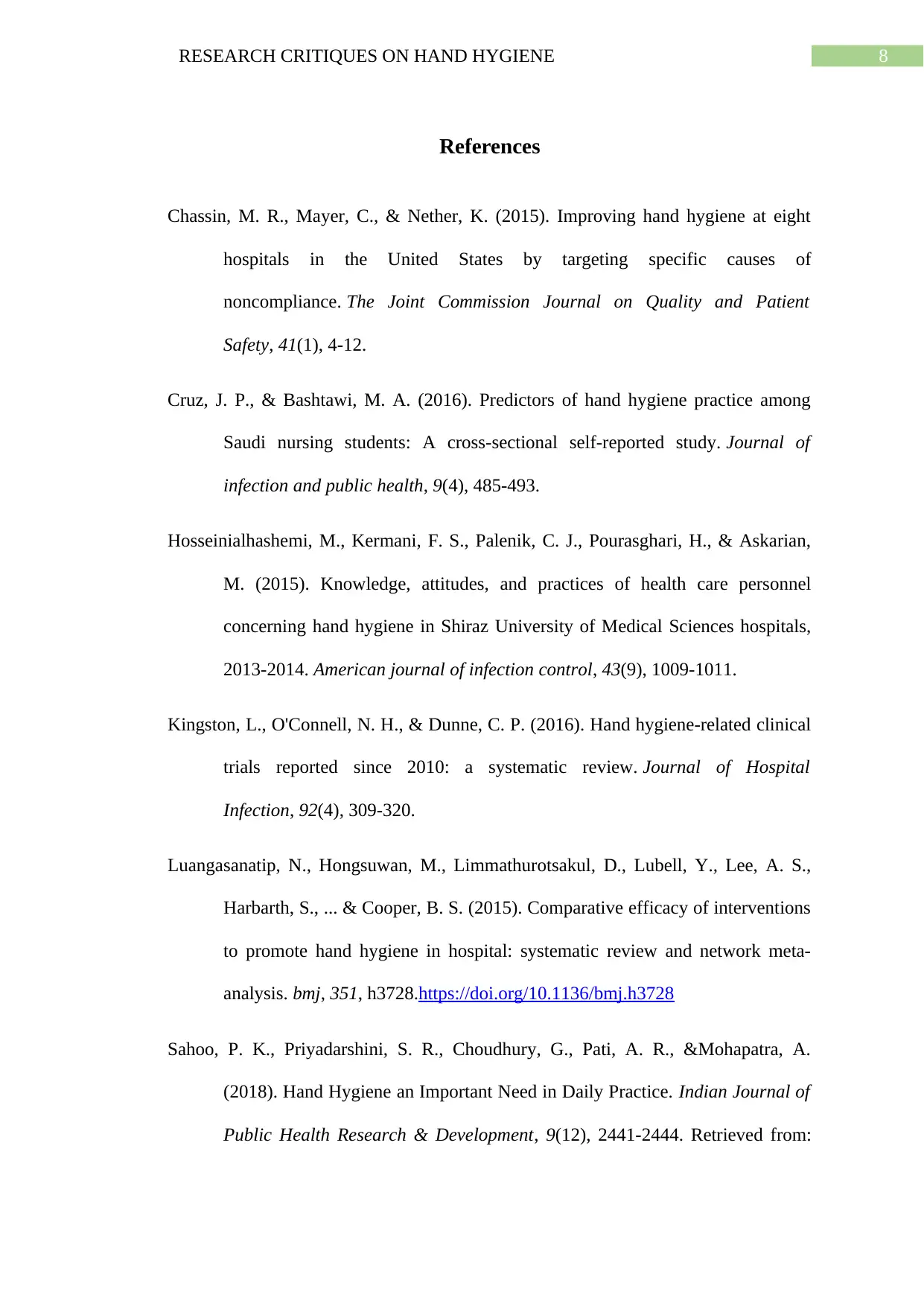
8RESEARCH CRITIQUES ON HAND HYGIENE
References
Chassin, M. R., Mayer, C., & Nether, K. (2015). Improving hand hygiene at eight
hospitals in the United States by targeting specific causes of
noncompliance. The Joint Commission Journal on Quality and Patient
Safety, 41(1), 4-12.
Cruz, J. P., & Bashtawi, M. A. (2016). Predictors of hand hygiene practice among
Saudi nursing students: A cross-sectional self-reported study. Journal of
infection and public health, 9(4), 485-493.
Hosseinialhashemi, M., Kermani, F. S., Palenik, C. J., Pourasghari, H., & Askarian,
M. (2015). Knowledge, attitudes, and practices of health care personnel
concerning hand hygiene in Shiraz University of Medical Sciences hospitals,
2013-2014. American journal of infection control, 43(9), 1009-1011.
Kingston, L., O'Connell, N. H., & Dunne, C. P. (2016). Hand hygiene-related clinical
trials reported since 2010: a systematic review. Journal of Hospital
Infection, 92(4), 309-320.
Luangasanatip, N., Hongsuwan, M., Limmathurotsakul, D., Lubell, Y., Lee, A. S.,
Harbarth, S., ... & Cooper, B. S. (2015). Comparative efficacy of interventions
to promote hand hygiene in hospital: systematic review and network meta-
analysis. bmj, 351, h3728.https://doi.org/10.1136/bmj.h3728
Sahoo, P. K., Priyadarshini, S. R., Choudhury, G., Pati, A. R., &Mohapatra, A.
(2018). Hand Hygiene an Important Need in Daily Practice. Indian Journal of
Public Health Research & Development, 9(12), 2441-2444. Retrieved from:
References
Chassin, M. R., Mayer, C., & Nether, K. (2015). Improving hand hygiene at eight
hospitals in the United States by targeting specific causes of
noncompliance. The Joint Commission Journal on Quality and Patient
Safety, 41(1), 4-12.
Cruz, J. P., & Bashtawi, M. A. (2016). Predictors of hand hygiene practice among
Saudi nursing students: A cross-sectional self-reported study. Journal of
infection and public health, 9(4), 485-493.
Hosseinialhashemi, M., Kermani, F. S., Palenik, C. J., Pourasghari, H., & Askarian,
M. (2015). Knowledge, attitudes, and practices of health care personnel
concerning hand hygiene in Shiraz University of Medical Sciences hospitals,
2013-2014. American journal of infection control, 43(9), 1009-1011.
Kingston, L., O'Connell, N. H., & Dunne, C. P. (2016). Hand hygiene-related clinical
trials reported since 2010: a systematic review. Journal of Hospital
Infection, 92(4), 309-320.
Luangasanatip, N., Hongsuwan, M., Limmathurotsakul, D., Lubell, Y., Lee, A. S.,
Harbarth, S., ... & Cooper, B. S. (2015). Comparative efficacy of interventions
to promote hand hygiene in hospital: systematic review and network meta-
analysis. bmj, 351, h3728.https://doi.org/10.1136/bmj.h3728
Sahoo, P. K., Priyadarshini, S. R., Choudhury, G., Pati, A. R., &Mohapatra, A.
(2018). Hand Hygiene an Important Need in Daily Practice. Indian Journal of
Public Health Research & Development, 9(12), 2441-2444. Retrieved from:
⊘ This is a preview!⊘
Do you want full access?
Subscribe today to unlock all pages.

Trusted by 1+ million students worldwide
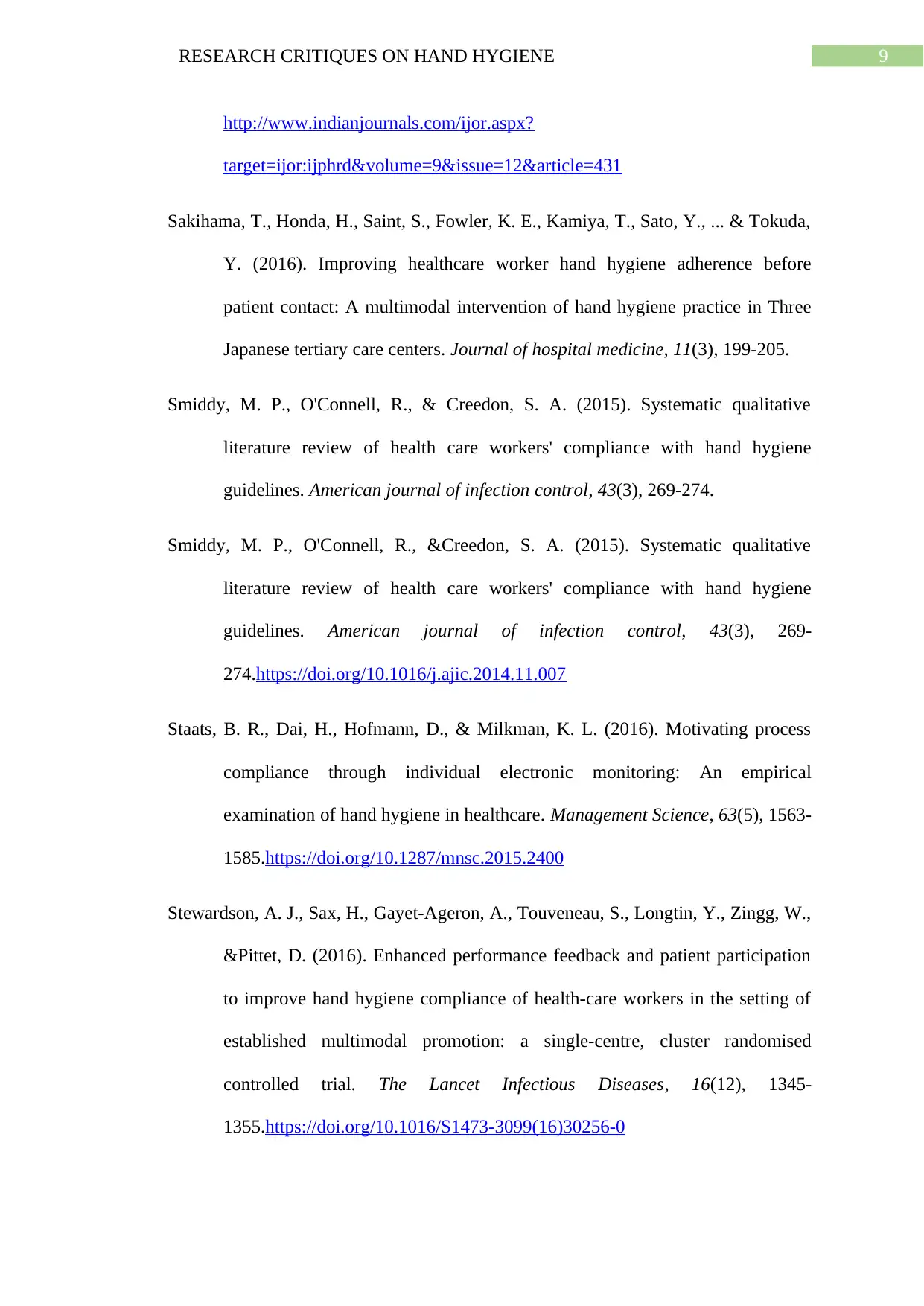
9RESEARCH CRITIQUES ON HAND HYGIENE
http://www.indianjournals.com/ijor.aspx?
target=ijor:ijphrd&volume=9&issue=12&article=431
Sakihama, T., Honda, H., Saint, S., Fowler, K. E., Kamiya, T., Sato, Y., ... & Tokuda,
Y. (2016). Improving healthcare worker hand hygiene adherence before
patient contact: A multimodal intervention of hand hygiene practice in Three
Japanese tertiary care centers. Journal of hospital medicine, 11(3), 199-205.
Smiddy, M. P., O'Connell, R., & Creedon, S. A. (2015). Systematic qualitative
literature review of health care workers' compliance with hand hygiene
guidelines. American journal of infection control, 43(3), 269-274.
Smiddy, M. P., O'Connell, R., &Creedon, S. A. (2015). Systematic qualitative
literature review of health care workers' compliance with hand hygiene
guidelines. American journal of infection control, 43(3), 269-
274.https://doi.org/10.1016/j.ajic.2014.11.007
Staats, B. R., Dai, H., Hofmann, D., & Milkman, K. L. (2016). Motivating process
compliance through individual electronic monitoring: An empirical
examination of hand hygiene in healthcare. Management Science, 63(5), 1563-
1585.https://doi.org/10.1287/mnsc.2015.2400
Stewardson, A. J., Sax, H., Gayet-Ageron, A., Touveneau, S., Longtin, Y., Zingg, W.,
&Pittet, D. (2016). Enhanced performance feedback and patient participation
to improve hand hygiene compliance of health-care workers in the setting of
established multimodal promotion: a single-centre, cluster randomised
controlled trial. The Lancet Infectious Diseases, 16(12), 1345-
1355.https://doi.org/10.1016/S1473-3099(16)30256-0
http://www.indianjournals.com/ijor.aspx?
target=ijor:ijphrd&volume=9&issue=12&article=431
Sakihama, T., Honda, H., Saint, S., Fowler, K. E., Kamiya, T., Sato, Y., ... & Tokuda,
Y. (2016). Improving healthcare worker hand hygiene adherence before
patient contact: A multimodal intervention of hand hygiene practice in Three
Japanese tertiary care centers. Journal of hospital medicine, 11(3), 199-205.
Smiddy, M. P., O'Connell, R., & Creedon, S. A. (2015). Systematic qualitative
literature review of health care workers' compliance with hand hygiene
guidelines. American journal of infection control, 43(3), 269-274.
Smiddy, M. P., O'Connell, R., &Creedon, S. A. (2015). Systematic qualitative
literature review of health care workers' compliance with hand hygiene
guidelines. American journal of infection control, 43(3), 269-
274.https://doi.org/10.1016/j.ajic.2014.11.007
Staats, B. R., Dai, H., Hofmann, D., & Milkman, K. L. (2016). Motivating process
compliance through individual electronic monitoring: An empirical
examination of hand hygiene in healthcare. Management Science, 63(5), 1563-
1585.https://doi.org/10.1287/mnsc.2015.2400
Stewardson, A. J., Sax, H., Gayet-Ageron, A., Touveneau, S., Longtin, Y., Zingg, W.,
&Pittet, D. (2016). Enhanced performance feedback and patient participation
to improve hand hygiene compliance of health-care workers in the setting of
established multimodal promotion: a single-centre, cluster randomised
controlled trial. The Lancet Infectious Diseases, 16(12), 1345-
1355.https://doi.org/10.1016/S1473-3099(16)30256-0
Paraphrase This Document
Need a fresh take? Get an instant paraphrase of this document with our AI Paraphraser
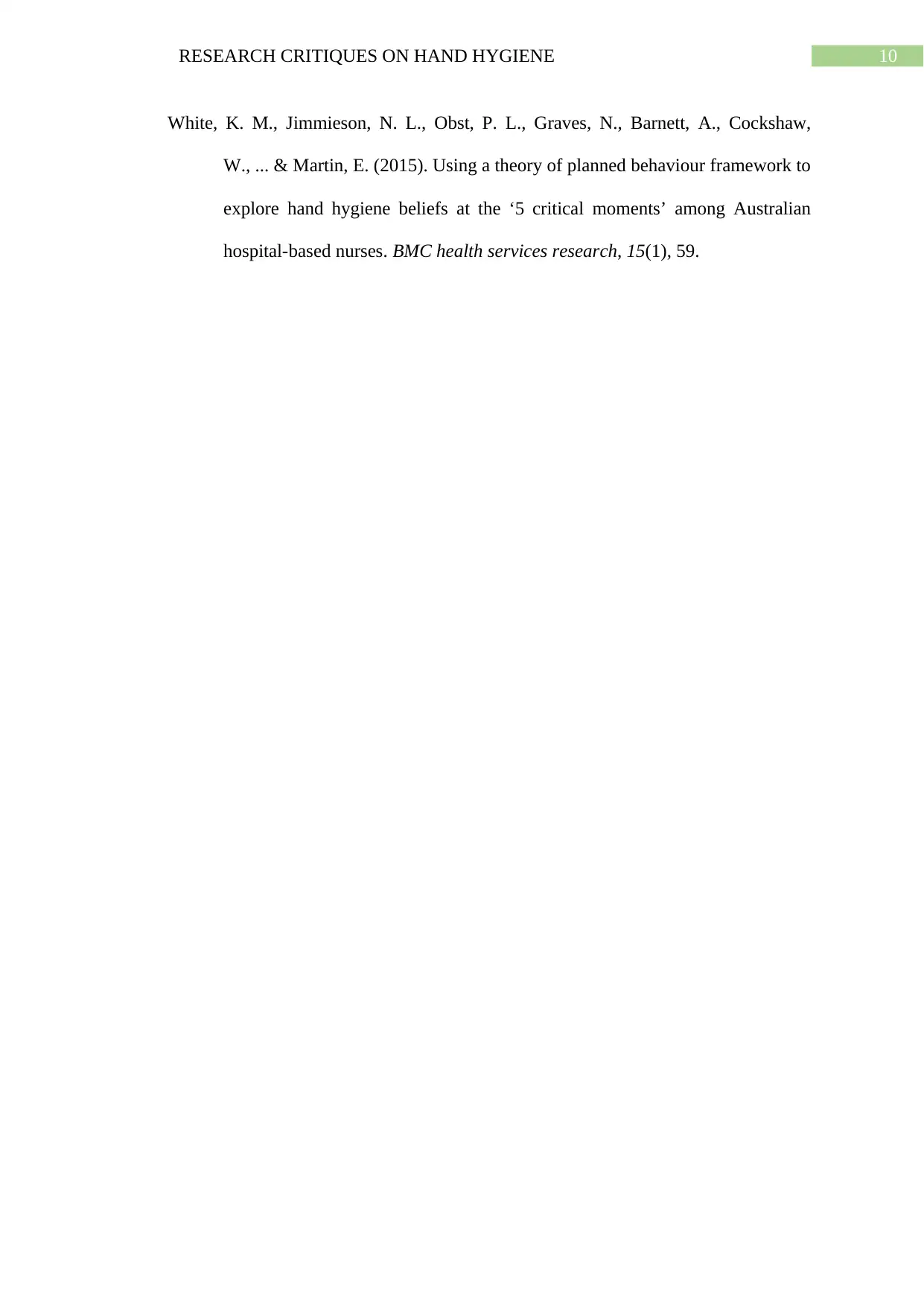
10RESEARCH CRITIQUES ON HAND HYGIENE
White, K. M., Jimmieson, N. L., Obst, P. L., Graves, N., Barnett, A., Cockshaw,
W., ... & Martin, E. (2015). Using a theory of planned behaviour framework to
explore hand hygiene beliefs at the ‘5 critical moments’ among Australian
hospital-based nurses. BMC health services research, 15(1), 59.
White, K. M., Jimmieson, N. L., Obst, P. L., Graves, N., Barnett, A., Cockshaw,
W., ... & Martin, E. (2015). Using a theory of planned behaviour framework to
explore hand hygiene beliefs at the ‘5 critical moments’ among Australian
hospital-based nurses. BMC health services research, 15(1), 59.
1 out of 11
Related Documents
Your All-in-One AI-Powered Toolkit for Academic Success.
+13062052269
info@desklib.com
Available 24*7 on WhatsApp / Email
![[object Object]](/_next/static/media/star-bottom.7253800d.svg)
Unlock your academic potential
Copyright © 2020–2025 A2Z Services. All Rights Reserved. Developed and managed by ZUCOL.





